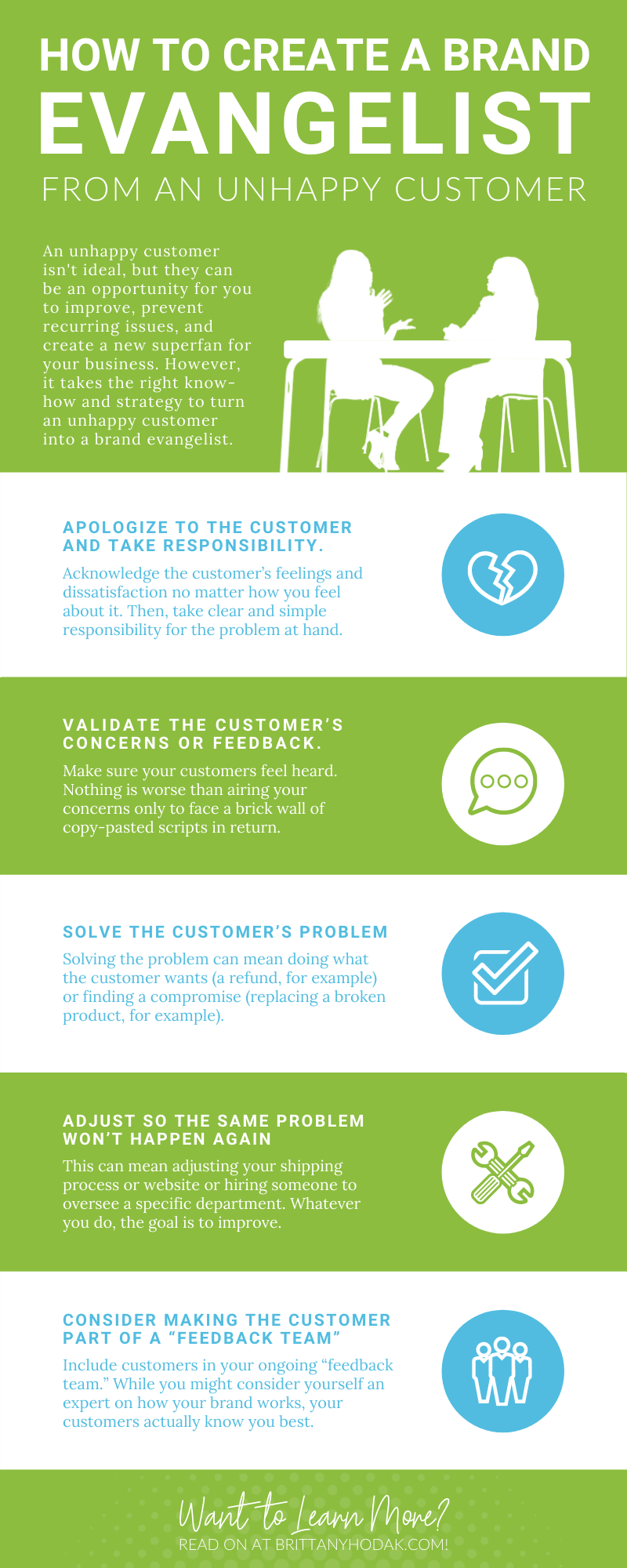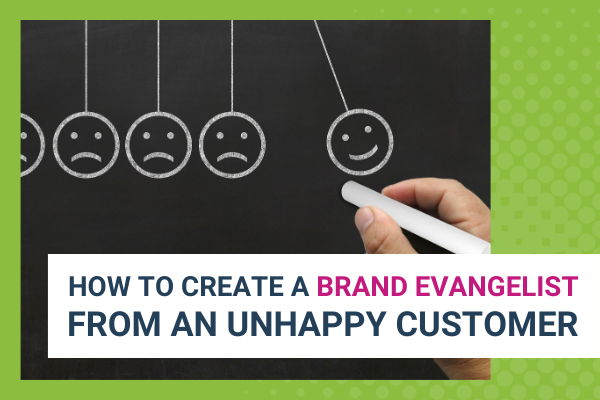Even if you have the best intentions all of the time, sometimes things won’t work out as planned. Maybe an order was delivered incorrectly or perhaps a customer service team member gave the wrong information accidentally. No matter what happened, it’s normal to find yourself facing an unhappy customer from time to time. That being said, an unhappy customer doesn’t have to be a death sentence for your brand. In fact, it’s an opportunity to improve, do better long-term, and create a new superfan for your business. However, it takes the right know-how and strategy to turn an unhappy customer into a brand evangelist.
1. Apologize to the customer and take responsibility.
First, we’ve all seen our fair share of bad apologies. From celebrities to politicians, it’s easy to remember a time when someone struggled to take responsibility for their actions.
This isn’t just limited to individuals. Brands are also notoriously so bad at apologizing. In fact, a recent study found that most brands take an average of 3 tries to apologize fully with many taking things personally, as though this is an attack on their personal or company’s character. Next, they panic and act quickly in an attempt to “fix” the situation fast. It’s understandable. Negative feedback is scary, especially with so many people taking their grievances to social media.
Though instincts might tell you to jump into action immediately, take a minute to get in the right mindset. Criticism against your brand should never be taken personally, even if it’s public feedback. Remember that this is one person’s experience, and it doesn’t have to be an entire reflection of your brand. When you’re ready to apologize, be gracious but keep your cool.
While there’s no one-size-fits-all magic strategy to saying “I’m sorry,” this formula works never fails:
- Thanks: Start with a ‘thank you’ to the customer for their feedback.
- Acknowledge: Next, acknowledge the customer’s feelings and dissatisfaction no matter how you feel about it. You can’t argue with another person’s perception.
- Responsibility: Take clear and simple responsibility. This isn’t the time to play the blame game. Instead, let them know what went wrong. (Your support guide wasn’t clear, shipping was delayed, etc.)
- Action: Share any steps you’re taking to avoid this happening again in the future and how you’re solving this issue at the current moment.
This is a good process to follow no matter the situation, and it’s important to keep your customers at the heart of every interaction. Though it might be easier to just turn a blind eye to this feedback, it’s important that you take each fair criticism seriously, especially when it’s a public part of your brand image.
2. Validate the customer’s concerns or feedback.
Next, you have to make sure your customers feel heard. Nothing is worse than airing your complaints and concerns only to face a brick wall of copy-pasted scripts in return. When a customer expresses their dissatisfaction, they mostly just want to feel heard.
Unless your customer has a completely unfounded concern, it’s worth listening to what they have to say. Not only will this diffuse the situation, but it’s the first step in turning the experience around.
Realize that your customers might be hinting at something deeper with their feedback. Though someone might say on the phone that they’re mad about the return policy, this could really imply that they no longer trust you as a seller. Always dig deeper to determine what’s really going wrong if you want to improve.
The best way to understand this is through a real-world example. In 2011, Netflix was transitioning to online streaming. They suddenly dropped their $9.99 all-inclusive pricing in favor of separate fees for either streaming or DVDs, leading to customer upset across the nation.
What did CEO Reed Hastings do? He took responsibility and he validated the customer concerns. “I messed up,” he began in his letter to customers. “I owe you an explanation. It is clear from the feedback over the past two months that many members felt we lacked respect and humility in [our announcement]…I offer my sincere apology.” By taking clear responsibility and recognizing that they handled the change poorly, he regained customer trust.
3. Solve the customer’s problem.
Only once you’ve listened to the customer and ensured they felt heard are you ready for the next step. Then, it’s time to solve the customer’s problem. Solving the customer’s problem can look like a few different things:
- Replace the product
- Sending a discount or coupon
- Giving a full or partial refund
- Offering a free add-on
Creating superfans is all about showing that you’re not afraid to go above and beyond to make your customer feel appreciated. Not only do people want to feel understood, but they also want to get a solution quickly and easily.
Finding the right solution is a two-lane street. This isn’t always what the customer wants you to do (though it might be). It could also be finding a happy medium that works for both parties. For example, the customer might immediately want a full refund. Instead, you might offer to send a new product in exchange or have them pay for shipping on something new. It’s up to you to find the perfect compromise.
4. Set up safeguards so the same problem won’t happen again.
Customer service is something usually left to the support team. In reality, customer service has no real boundaries. It’s something everyone on your team should understand so you can deliver a high-level service experience with every customer interaction.
This is an opportunity to upgrade your strategy to ensure you never experience something like this again. It could mean reviewing your shipping process, updating content on your website, or hiring someone to oversee a specific department. There is no one-size-fits-all process, but most situations call for additional training for everyone, not just customer service team members.
You can see these safeguards in action if you take a glimpse back at the memorable 2017 Oscars. A brand known as PwC was responsible for counting and tracking ballots that evening, but there was a small mistake that resulted in the presenters having the wrong ballot at the time of the final Best Picture announcement. The wrong film was announced by the presenter, leading to an awkward TV blunder.
Not only did PwC take full responsibility and apologize, but they also interviewed with the BBC to share their new “watertight system” for award shows in the future. Though they undoubtedly took a hit to their reputation, they’ve come back stronger than ever.
5. Consider making the customer part of a “feedback team.”
Finally, a winning way to keep these mistakes from happening in the future is to include customers in your ongoing “feedback team.” While you might consider yourself an expert on how your brand works, your customers actually know you best. They know your strengths and weaknesses more than you do, and their feedback has never been more valuable.
You can’t afford not to put your customers’ opinions first. Customer-first companies are reportedly 60% more profitable than companies that don’t focus on customers. Asking some of your best customers what they like as well as what they dislike is a great way to improve long-term.
How do you get authentic feedback from customers? It’s all in your process. Consider these tips to make a real difference:
- Set goals: What are you trying to learn from your feedback? Set clear goals so you know why you’re asking for feedback.
- Open-ended: When talking to specific customers, don’t ask “yes” or “no” questions that are easy to ignore. Instead, drive real answers with open-ended questions like “What could be better about X?”
- Feedback form: A feedback form on your website can encourage quick responses for insights from larger groups. If you have a help guide, for instance, a simple poll asking “Was this helpful?” goes a long way.
- Personalize: Everyone wants to feel special. Asking certain customers (like repeat customers) for feedback and thanking them directly builds trust.
Never Miss an Opportunity to Improve
In conclusion, no matter how well prepared you are as a brand, customer mishaps will happen. You can’t satisfy every customer 100% of the time, but you can vow to turn those negative interactions into a chance to improve.
Sometimes you have to make a mistake (or several) to become a stronger company. The next time you find yourself on the other end of negative feedback, you know what to do. It’s all about putting empathy, compassion, and understanding first. From there, create a solution that works for you and the customer. Let these moments serve as the learning experiences they are so you can do even better in the future.
Too many businesses shy away from unhappy customers. In reality, this is an opportunity to create a lifelong superfan and strengthen your overall customer journey.

